Learn The Land at Bishop Mac
On a recent Sunday I was out behind Bishop Mac High School with one of the programs I facilitate with my colleague Annie. The program is called Learn The Land, and it’s a ton of fun. Together we have been exploring three different locations around Guelph over the past year and getting to know the local ecologies, including looking at herbaceous plants and identifying wildflowers. We’ve done a lot of wildlife tracking, and even a bit of wandering in the Eramosa River looking at what species inhabit the shallows there. When it comes to Bishop Mac, or the South End Community Park as it’s labelled on googlemaps, we had been there a couple of times in the past year, though both previous times were in the warmer months. We’ve observed the Osprey (Pandion haliaetus) nests, and went on a birding adventure with wildlife biologist Matt Iles but this was our first time out in the Winter months. Sadly there was no snow, but that didn’t mean we didn’t find anything to really dig into.
One thing I noticed right away after our circle for the morning was that the concrete pillar where I had recently seen Corvid tracks had been washed clean of all yolk and egg debris, except for a couple of shells at the base. I guess it would make sense with all of the rain we’d had over the past three weeks, but it is still impressive to me to return only a few weeks later and see how things can change so much, in such little time. Reminds me of the ephemeral nature of tracking, that we might miss some sign as it will quickly disappear under the right conditions.
We left the parking lot and tucked in along a trail between the baseball diamonds and field that had been planted in Soy (Glycine max) last year. When I was out tracking on December 27th, I had trailed some White-tailed Deer (Odocoileus virginianus) through the hills where the Deer were walking into these old harvested Soy fields and kicking up the snow and digging in for any beans which remained. Today we avoided the fields and made our way over the low rolling hills amidst the Common Juniper (Juniperus communis subsp. alpina var. megistocarpa), Common Buckthorn (Rhamnus cathartica), Scots Pine (Pinus sylvestris), and Apples (Malus spp.).
One of the first signs we really stopped to examine was some scat on the trail. This measured about 17 - 18 cm long (if all pieces were counted as one deposit), and about 1.7 - 1.9 cm in diameter. While according to Mammal Tracks and Sign (Elbroch 2019) the diameter falls within the high end of the range for a Red Fox (Vulpes vulpes) scat, and situated within the lower end of the Coyote (Canis latrans) range, the length would likely be too large for a Red Fox. My experience with this area, these trails, and the animals who occupy the area, I would suggest it this scat was deposited by a Coyote. I have read that scats made up of fruit and mast crops (nuts and seeds) can be a bigger diameter for Red Foxes. This is important because when I zoom in on the photo, the darker piece on the left most side appears to have a possible Grape (Vitis spp.) seed within it. I didn’t notice this in the field, but only when I took the time to zoom in on the image. I have found fruit in both Red Fox and Coyote scat in the past so the presence of fruit does not include or exclude either. If any reader has any counter claims, please let me know! I am eager to be challenged and to learn more.
To confuse and bother my identification I’m going to pull some more info from other books. In The Tracker’s Field Guide (Lowery 2013) Red Fox scat are described as having a “distinctive musky odor” which this scat did not have but could this be because it was older, possibly washed out by all the rain over the past few weeks? Lowery also describes Red Fox scat as having a diameter of 1.3 - 1.6 cm, and Coyote as 1.6 - 1.9 cm D. It is important to note James Lowery lives in California where the Western Coyote is smaller than the Eastern Coyote, even though they are the same species. In A Field Guide To Tracking Mammals in the Northeast (Spielman 2017) she describes Eastern Coyote scat is being between 1.9 to 3.8 cm D, and Red Fox scat as .95 - 1.9 cm D so this could fall under Red Fox for her measurements. Both Spielman and Paul Rezendes (Rezendes 1999) include notes on how Red Fox cannot break down larger bones as well as Coyotes can, so we would’ve been more likely to find bone fragments within the scat if it were from a Coyote. Sadly, we didn’t break it up to check for bone fragments. Maybe next time… but for now, I still believe this was left by a Coyote.
After the Coyote scat we took a closer look at some Eastern Cottontail Rabbit (Sylvilagus floridanus) tracks, discussing the number of toes (5 on the fronts, 4 on the hinds), but I won’t get into that too much as I already have before. But we continued along the trail, up a hill, until we came to a small grove of trees, with two interesting individuals on either side of the trail. The trees weren’t necessarily interesting because of which species they were, though this did come up later, but instead because of what they held. One, and you’ll have to imagine this as I didn’t get a photo, held a small frozen Apple like fruit tucked between some branches about 1.85 m (~6 ft) off of the ground. From the spot where we stopped we could see Apples in many trees along the trail and just off the trail. This behaviour is pretty tell tale of Red Squirrels (Tamiasciurus hudsonicus). Not only Apples, but Red Squirrels are also known to cache mushrooms, conifer seed cones and other fruit and mast in the crotches of branches of all sorts of trees. I have even found and eaten many cached Beaked Hazelnuts (Corylus cornuta) once in Algonquin. The Red Squirrel had seemed to know which nuts were the best for storage, as when we humans came through, we only found Hazelnuts with weevils in them. Sometimes the other animals know where to find the good stuff.
On the other side of the trail there was another possible Apple tree, but tucked within the branches was something else.
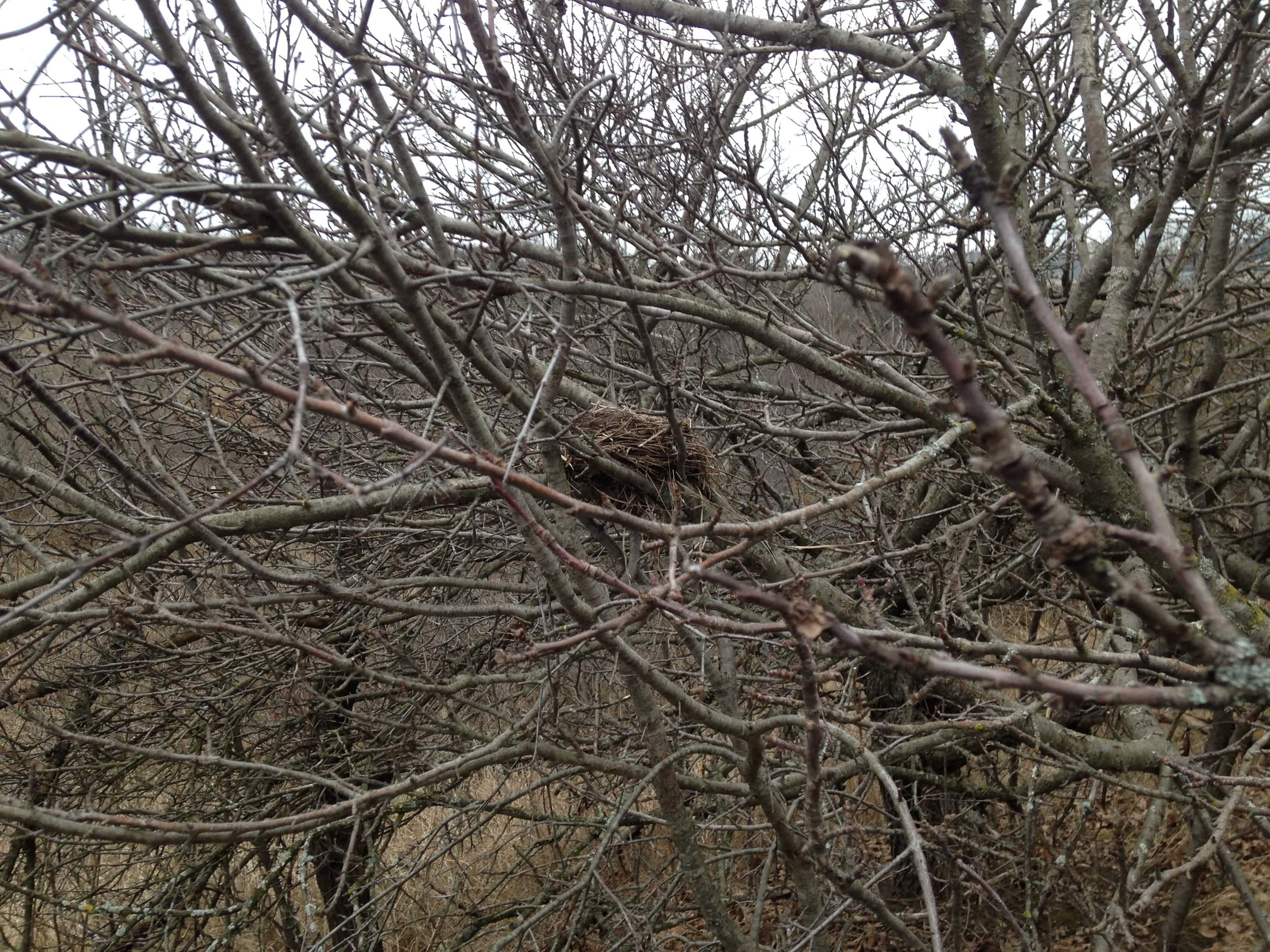
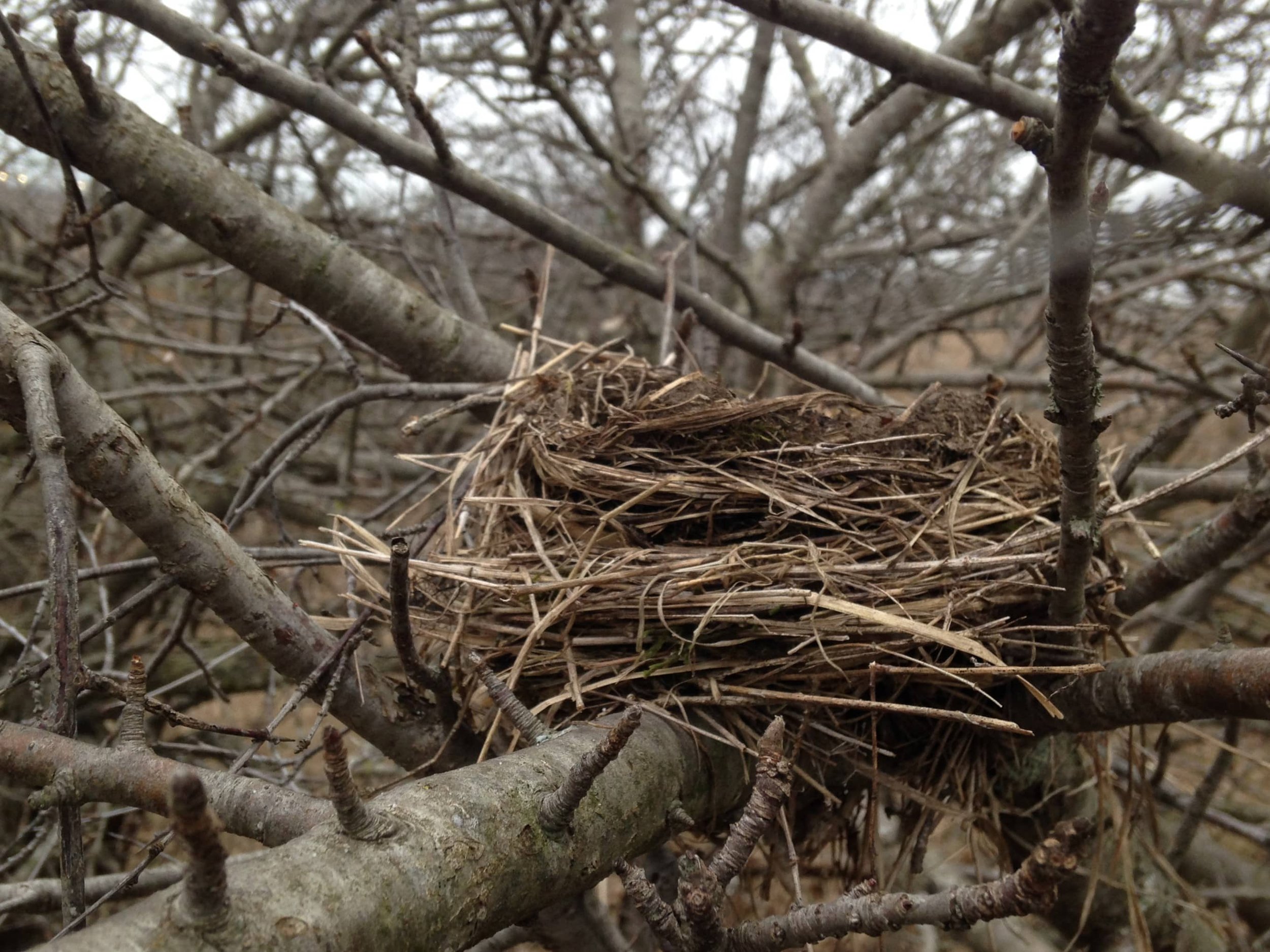
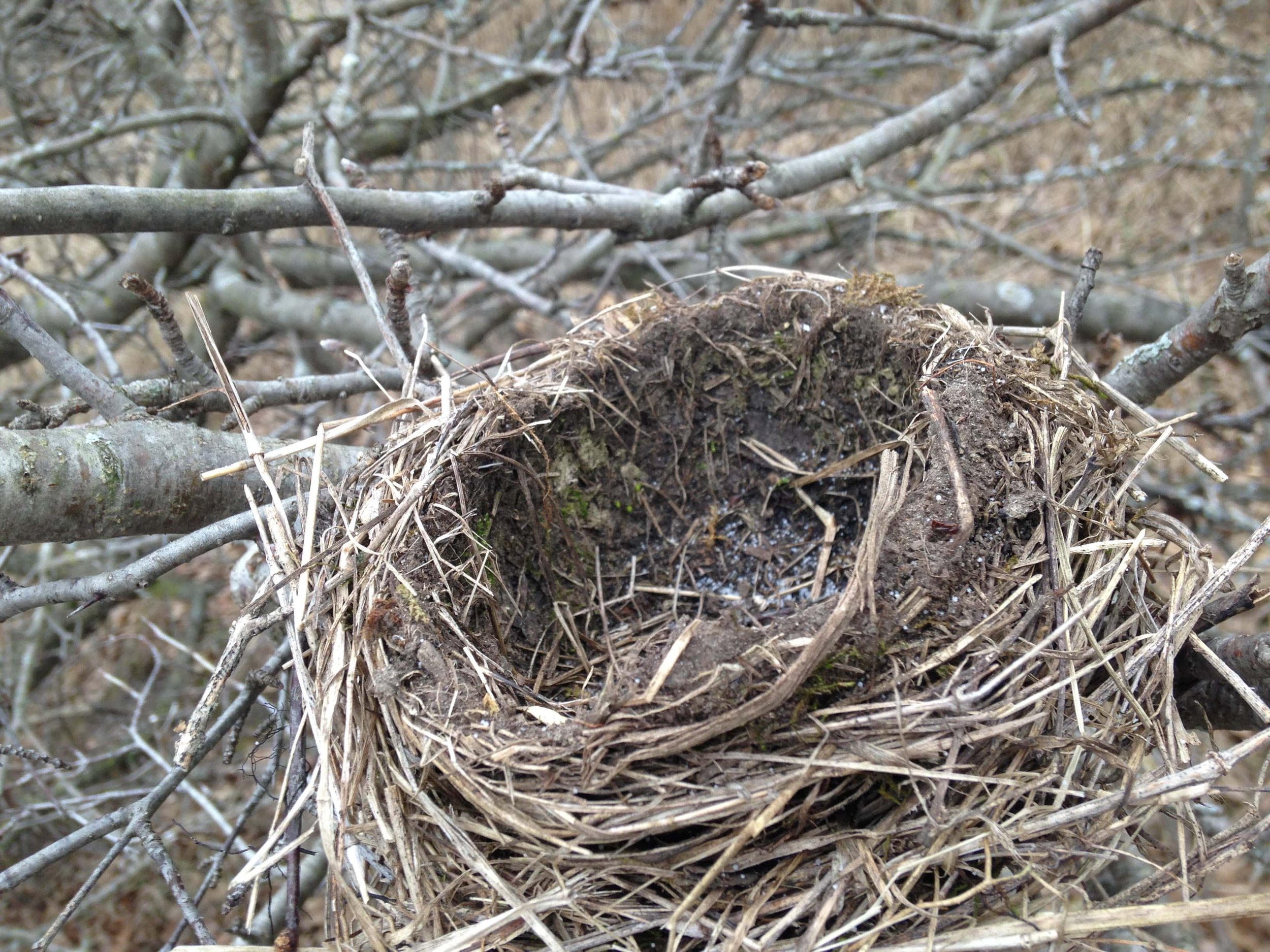
When I stood beside the nest, it was about as high as my eyeline, so about 170 cm off the ground nestled in the fork of the probable-Apple tree. The outside materials were mostly grasses, but the inside was lined with mud and mosses. The diameter on the outside was about 16 cm, and the cup diameter on the inside was about 14 cm. Considering the size, the materials used, the location, and the region, I would assume an American Robin (Turdus migratorius) had made this nest. As I check it over in the field guides at home, all of the details seem correct. This is a useful nest to know as Robins are incredibly common, and therefore one of the most common nests one will likely encounter. I do wonder though, who else lines a grassy nest with mud? According to the Peterson Field Guide to North American Bird Nests (McFarland, Monjello, Moskowitz, 2021), a couple of the other Thrushes line their nests with mud. I wonder if they also build around the same height, and with the same nest dimensions? According to Bird Behaviour volume 1 (Stokes, 1979) American Robins begin building their nests and breeding between April - July. This could mean that the Robins were occupying this nest while the tree was in full blossom. What a lovely place to brood and raise young! I am happy knowing that these Robin had a beautiful Spring home.
We don’t make it too far too quick when we’re out with the Learn The Land crew as there is so much to see and notice. We had only gone a few feet when we encountered a dark something along the branches of a few small shrubs.
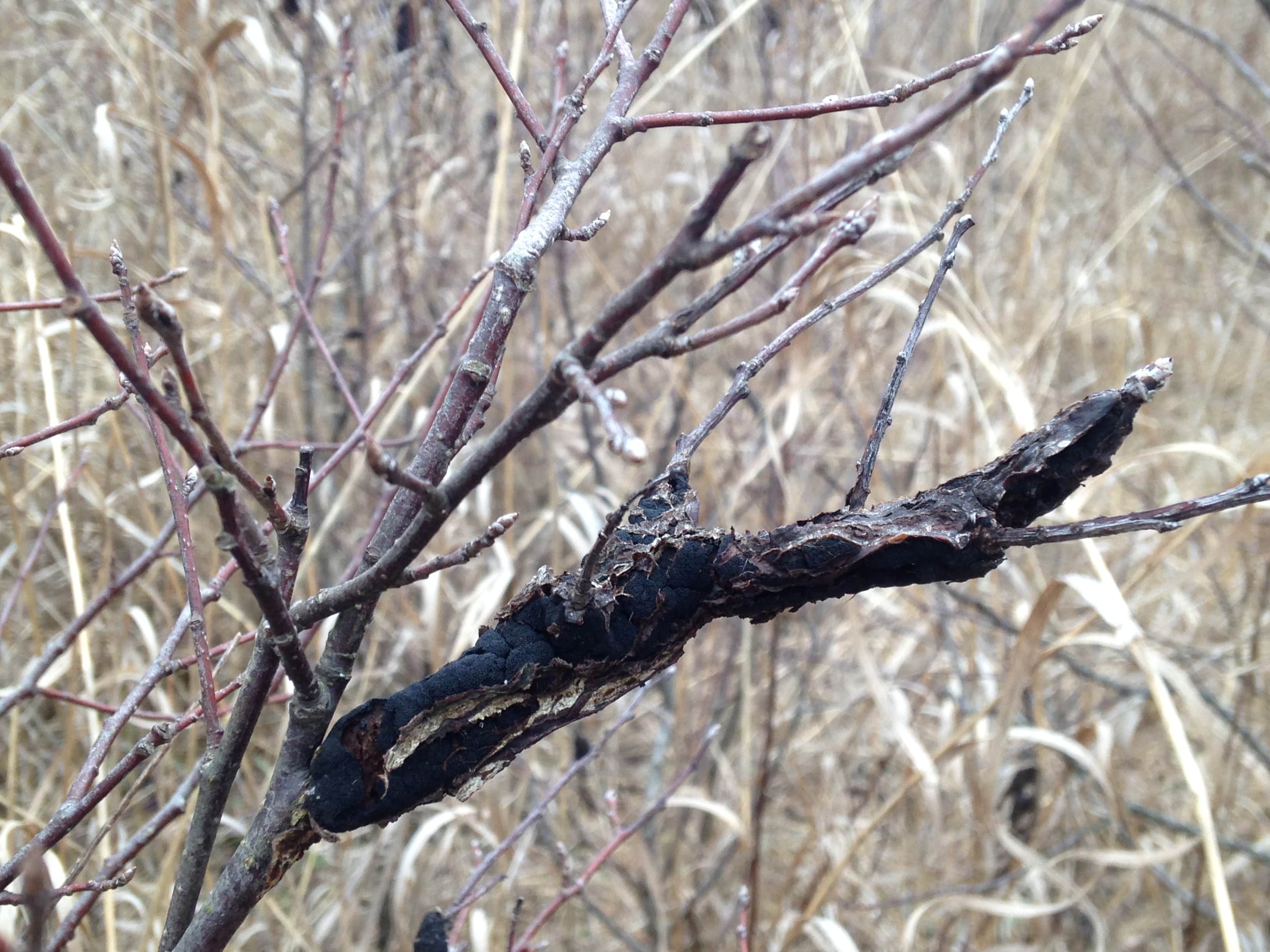

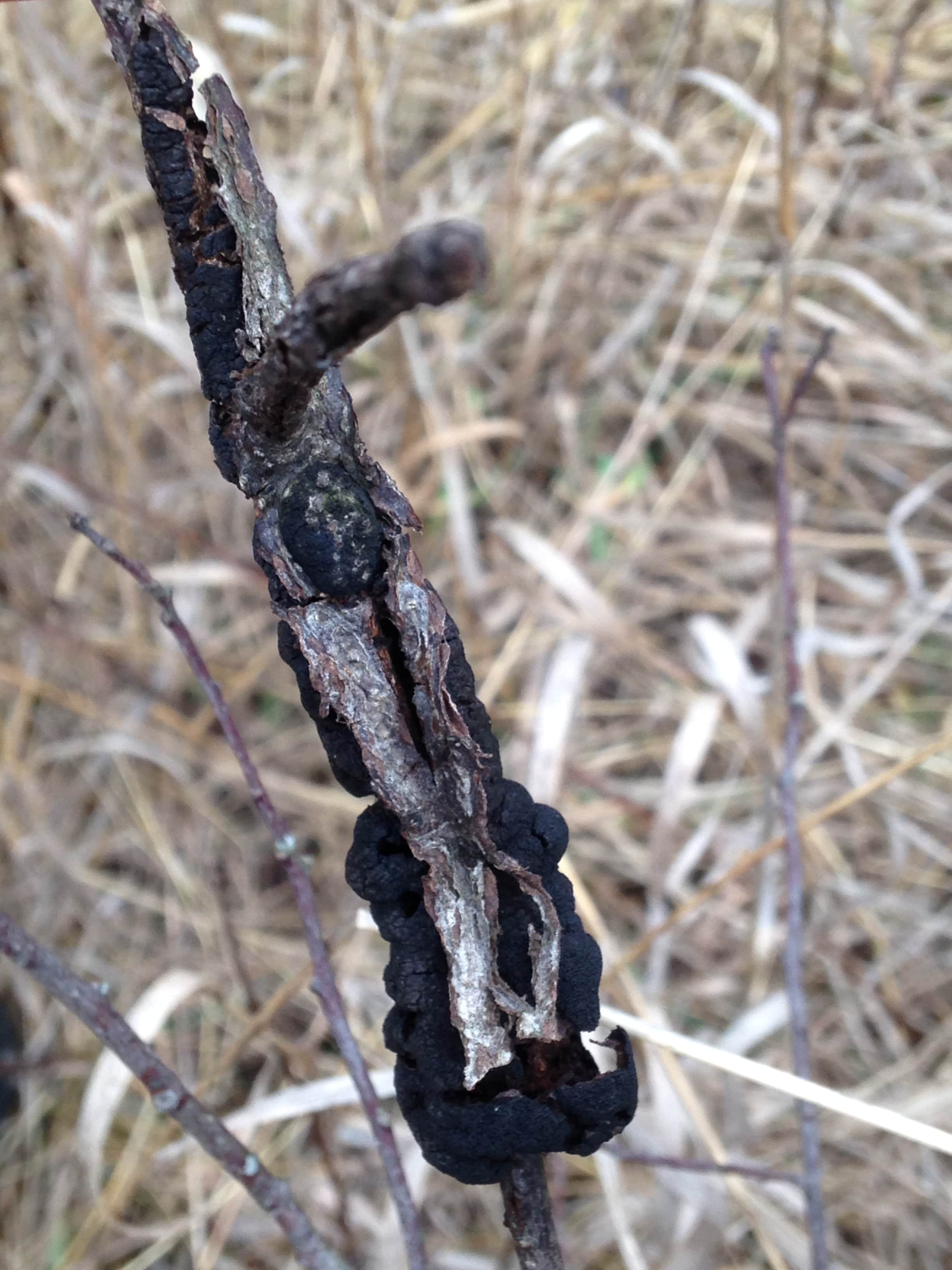
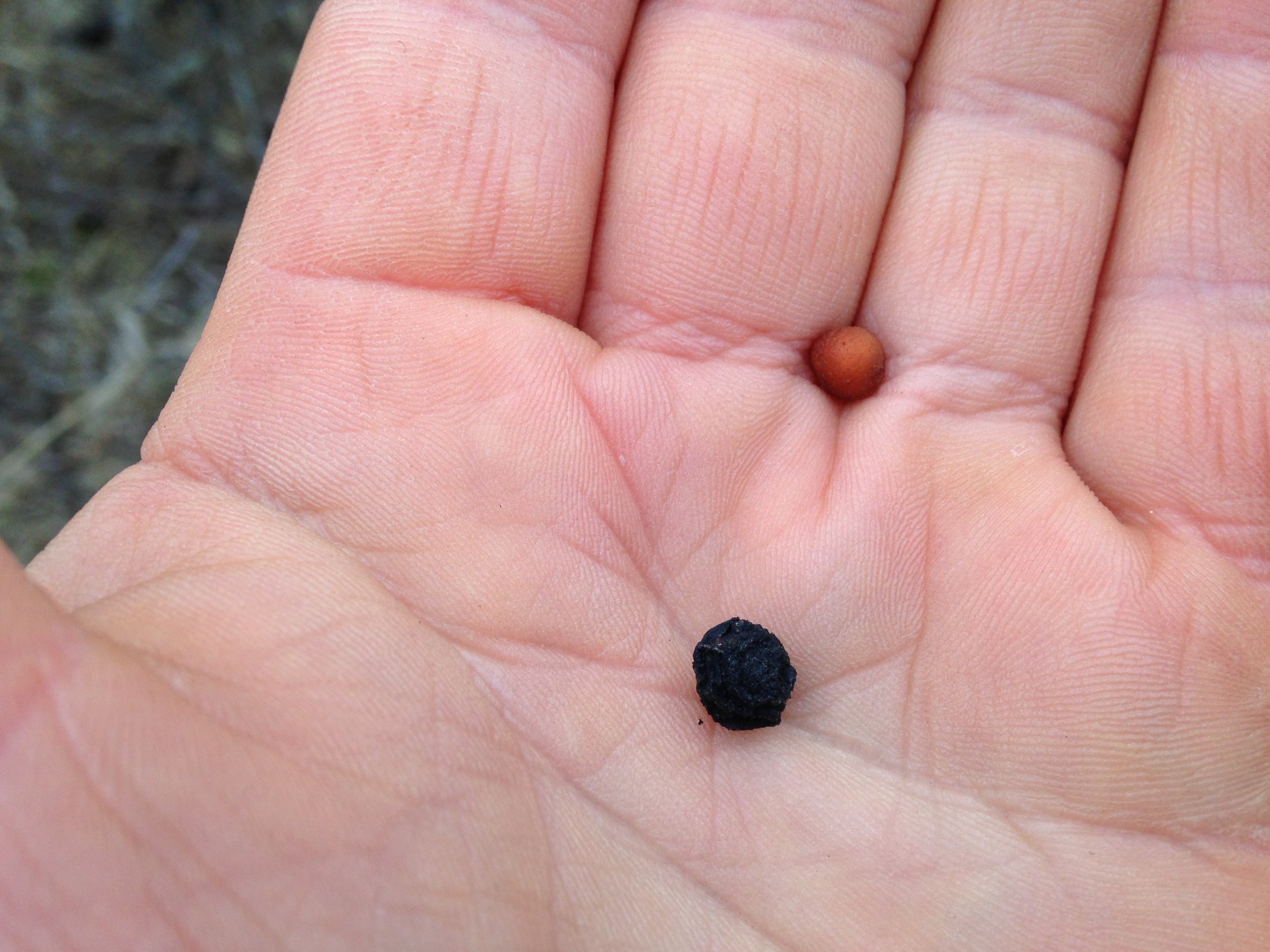
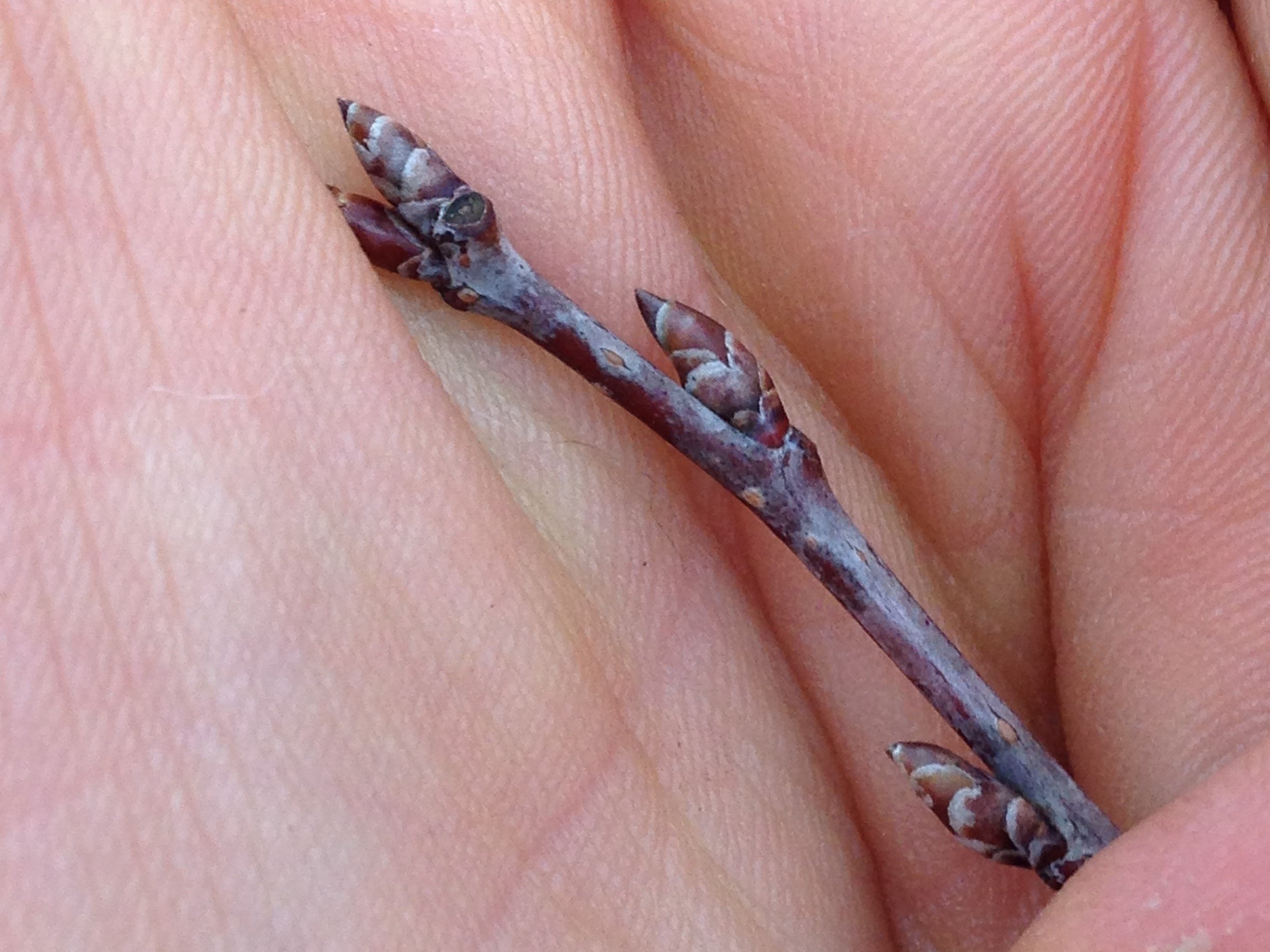
We ended up investigating the few fruit and seeds still remaining on the plant and also checking out the branches for any indications as to who this shrub was, which in turn may help us know who the strange black stuff was. In time it was revealed that this shrub was likely in the Prunus genus (most likely Prunus virginiana, Chokecherry, or the Anishnaabemowin name Asa/isaweminagaawanzh) and that the black stuff ornamenting the twigs and branches was Black-knot Fungus (Apiosporina morbosa). Chokecherries are common in the area around Bishop Mac, and across the city. The birds like them and I do too. But the interesting thing we noted was the seed. While I have seen many fresh Chokecherry seeds throughout the years, it was notable that this was my second time handling the seed when the fruit wasn’t ripe for eating. The first time I had noticed the Chokecherry seed was the previous time we had visited the forest behind Bishop Mac and we had found a cache of Chokecherry seeds at the base of a large Sugar Maple (Acer saccharum). It had been a mystery then, but when we checked out the seed in hand we seemed to click that this was the same seed that we had noticed before. We were elated that this mystery had finally been revealed. Good reminder that visiting places through the seasons can deepen the relationship and answer previous unknowns.
As for the Black-knot Fungus, it kind of looks like Raccoon (Procyon lotor) or Domestic Cat (Felis catus) scat got stuck on the twig while the animal was trying to eat the cherries. The texture along the surface of the growth was rough, but a very fine rough, similar to fine grade sandpaper. The surface was cracked and fissured and radiated out from the inside of the twigs, but also appeared to be clasping the twigs. It seems that the fungal spores spread in Spring, landing on new growth and then getting in under the bark. Once the infection starts to grow, a gall appears in the area. This gall is generally the same colour as the plant tissue. The fungus grows within the gall and these galls start to get bigger by the following spring. They then bust out, splitting the bark. The fungus initially has a kind of light brown to olive greenish colour, but turns black and brittle as it ages. The knots we were finding were probably about 2 years old based on the size and colour. The fungus ends up girdling the branch and the limb dies. These fungal knots can become home to some insects, especially Peach Tree Borer Moth (Synanthedon exitiosa). The fungus doesn’t really kill the tree, but can lead to windbreak due to weakened limbs, and may hinder fruit production if the infection is extensive enough. I believe I will be taking a closer look at the Black-knot in the future.
From here we spread out and practiced making our way over the rolling hills with Owl Eyes engaged, taking in as much as we could. I found some old bone fragments at the top of a hill and a White-tailed Deer tibia at the edge of a field, but it was getting late and we didn’t get to study much more in detail and depth. It would have been nice to check out the Red Squirrel (Tamiasciurus hudsonicus) drey which someone had found in a conifer but I guess I felt a little too pressed for time. I’ll just have to go back to Bishop Mac soon and try and find it from the description that was shared. I think it was in a Scots Pine (Pinus sylvestris)?
I haven’t got to write much about the adventures I’ve had with the crew from Learn The Land this year, but it has been quite an amazing time. We’ve seen so much, learned so much, and have been really leaning into our connections with the land and each other. I have been inspired and moved a couple of times, have pages full of notes and questions, many of which I’ll never have the time to look up...but maybe. I am excited to get together for our next two outings, but sad to know that this cohort will be disbanding in March. I guess that just reminds of the possibility of a new crew, with new eyes and lots of new questions to pursue. This learning the land stuff never ends.
To learn more :
Learn The Land : Guelph Outdoor School’s Naturalist Study Program
Mammal Tracks and Sign by Mark Elbroch; Stackpole Books, 2019
The Tracker’s Field Guide by James C. Lowery; Falcon Guides, 2013
A Field Guide To Tracking Mammals in the Northeast by Linda J. Spielman; The Countryman Press, 2017
Tracking and The Art of Seeing by Paul Rezendes; Harper Perennial, 1999
Peterson Field Guide to North American Bird Nests by Casey McFarland, Matthew Monjello, David Moskowitz; Houghton Mifflin Harcourt, 2021
Bird Behaviour volume 1 by Donald Stokes; Little, Brown, 1979
OMAFRA guide to Black-knot Fungus




